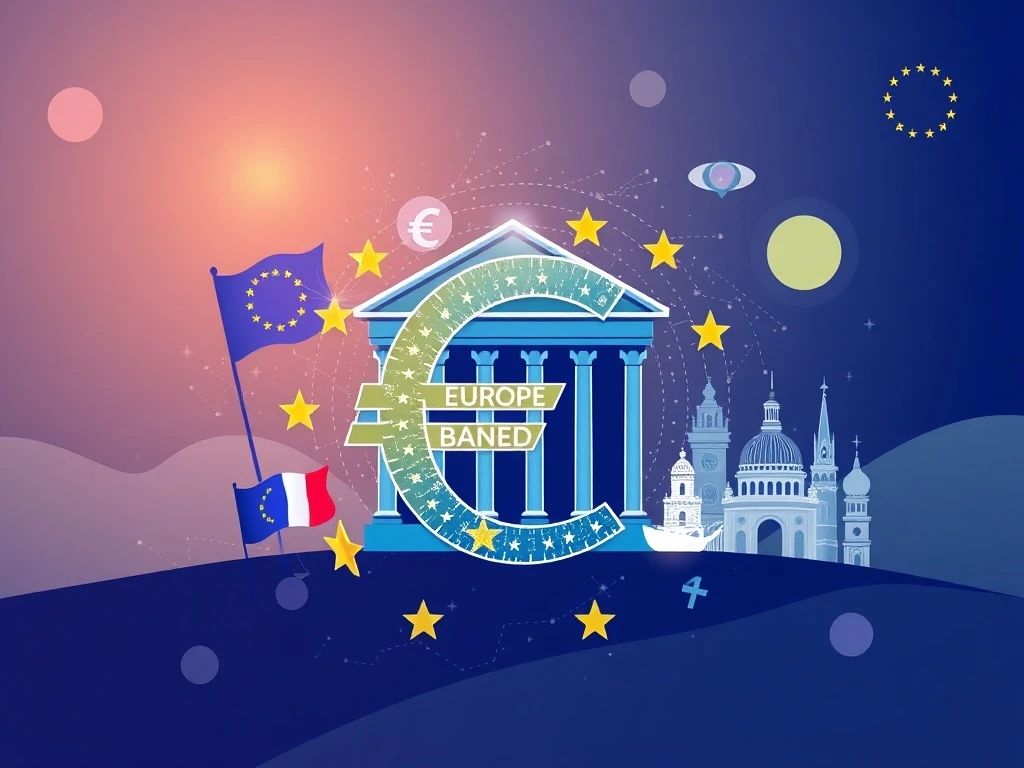Pivotal Euro-Backed Stablecoin: ODDO BHF Launches EUROD Under MiCA

The cryptocurrency landscape continues its rapid evolution. A significant development has emerged from Europe, signaling a shift in the stablecoin market. Crypto enthusiasts and financial institutions alike are watching closely as traditional banks embrace digital assets. This movement challenges the long-standing dominance of dollar-pegged tokens. Specifically, the launch of a new euro-backed stablecoin marks a pivotal moment.
ODDO BHF’s Bold Move with EUROD Stablecoin
Franco-German banking group ODDO BHF has officially launched its new euro-backed stablecoin, named EUROD. This initiative operates fully under the European Union’s groundbreaking MiCA regulation. The announcement came on Wednesday, detailing the structure behind this innovative digital asset. ODDO BHF will serve as the primary issuer of the EUROD stablecoin. Meanwhile, market-making platform Flowdesk provides essential liquidity. Fireblocks, a leading provider, supplies the crucial tokenization infrastructure. Consequently, the EUROD is poised for robust market integration.
Guy de Leusse, deputy chief operating officer at ODDO BHF, highlighted the strategic importance. He stated the group recognized the need for a European solution. This solution, denominated in euros, offers a vital alternative to US dollar-denominated stablecoins. Stablecoins are digital tokens. They maintain a peg to traditional currencies like the euro. The new EUROD token will first list on Bit2Me, a Spanish-based crypto exchange. ODDO BHF itself boasts a rich history. It formed in 2016 from the merger of France’s ODDO bank (founded 1849) and Germany’s BHF-BANK (founded 1854). The bank operates across France, Tunisia, Germany, and Switzerland, underscoring its European reach.
Challenging Dollar Dominance with European Stablecoins
The stablecoin market has historically seen significant dollar dominance. Tokens like Tether’s USDt (USDT) and Circle’s USDC (USDC) have held the largest market share globally. In fact, these two account for over 83% of the total $306.35 billion stablecoin market capitalization, according to DefiLlama data. However, this landscape is gradually changing. The rest of the world, particularly Europe, shows increasing interest in developing stablecoins. These new tokens are pegged to their own fiat currencies.
Several notable initiatives highlight this trend in European stablecoins. For instance, on April 20, 2025, Société Générale’s regulated digital asset arm, SG-Forge, introduced EUR CoinVertible. This euro-denominated stablecoin runs on Ethereum. It is available to qualified institutional investors onboarded by the bank. Furthermore, in July, AllUnity made headlines. This joint venture, backed by Flow Traders, Deutsche Bank’s DWS, and Galaxy, released EURAU. This regulated euro-pegged stablecoin became publicly available on July 31. Moreover, nine other European banks announced plans to launch a collective euro-pegged stablecoin. This ambitious project is expected to launch in the second half of 2026. These collective efforts demonstrate a strong commitment to diversifying the stablecoin market.
The Crucial Role of MiCA Regulation
The regulatory environment plays a critical role in the growth of new digital assets. The European Union’s MiCA regulation provides a clear framework for stablecoin issuers. This framework fosters trust and encourages adoption. Bhau Kotecha, co-founder of Paxos Labs, observed that USD-backed stablecoins benefited from a multi-year head start. To achieve comparable growth, euro and other fiat-backed issuers require unique adoption strategies. These strategies must focus on the right partnerships, use cases, and liquidity pathways. MiCA helps establish the necessary legal certainty for these strategies.
Momentum appears to be building in Europe. This follows the United States’ passage of the GENIUS Act stablecoin bill in July 2025. Europe aims to develop its own homegrown, euro-denominated stablecoins. In September, European Central Bank (ECB) president Christine Lagarde issued a caution. She warned that the European Union needs to close regulatory loopholes around foreign stablecoins. Unregulated issuers, she argued, could draw liquidity away from the euro and the broader EU financial system. Therefore, robust domestic offerings like the EUROD stablecoin become increasingly important. Pierre Gramegna, managing director of the European Stability Mechanism (ESM), also weighed in. Speaking during a hearing on the eurozone’s economic outlook, he stated Europe should facilitate the generation of euro-denominated stablecoins by domestic issuers. This highlights a coordinated effort to strengthen Europe’s digital financial infrastructure.
Driving Adoption for Euro-Backed Stablecoins
The future success of the euro-backed stablecoin market depends on several factors. These include strong regulatory backing, strategic partnerships, and diverse use cases. The launch of EUROD by ODDO BHF, under the clear guidelines of MiCA regulation, provides a solid foundation. It offers a secure and compliant option for businesses and individuals. This development could catalyze broader institutional adoption across Europe. As more financial entities enter the space, liquidity will deepen, making these tokens more attractive for various transactions.
While Europe has debated a digital euro, a central bank digital currency, since 2023, its launch is not expected before 2029. Consequently, privately issued European stablecoins like EUROD fill an immediate need. They bridge the gap between traditional finance and the burgeoning digital economy. These tokens offer instant settlement, lower transaction costs, and enhanced transparency. They provide a practical solution for cross-border payments and decentralized finance applications. The market is eager for alternatives to the dollar-dominated stablecoin ecosystem. ODDO BHF’s EUROD positions itself as a key player in this evolving financial landscape. Its success could inspire further innovation and competition. This ultimately benefits consumers and businesses seeking efficient digital payment solutions.









